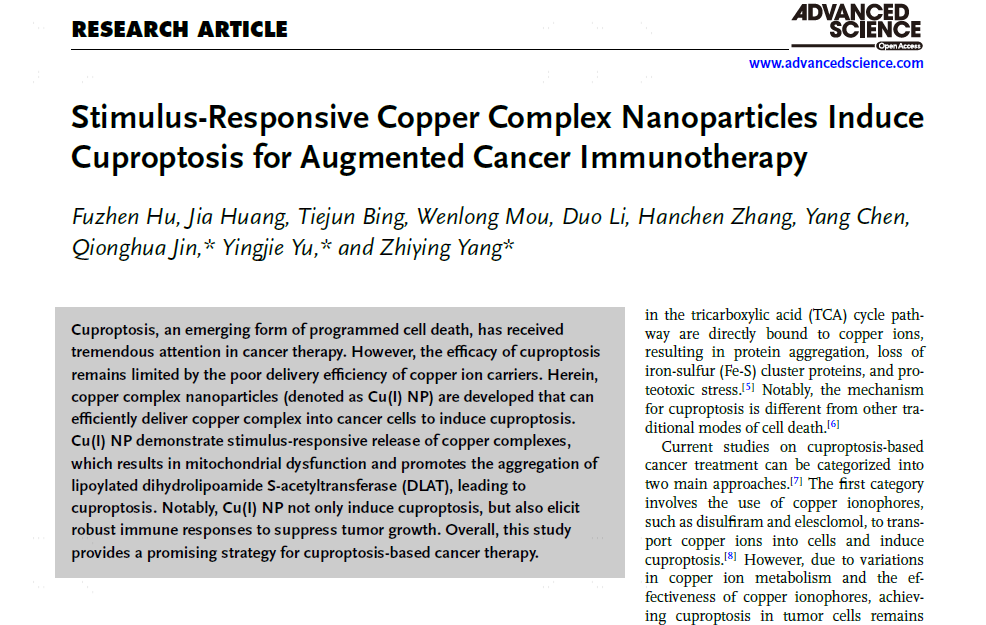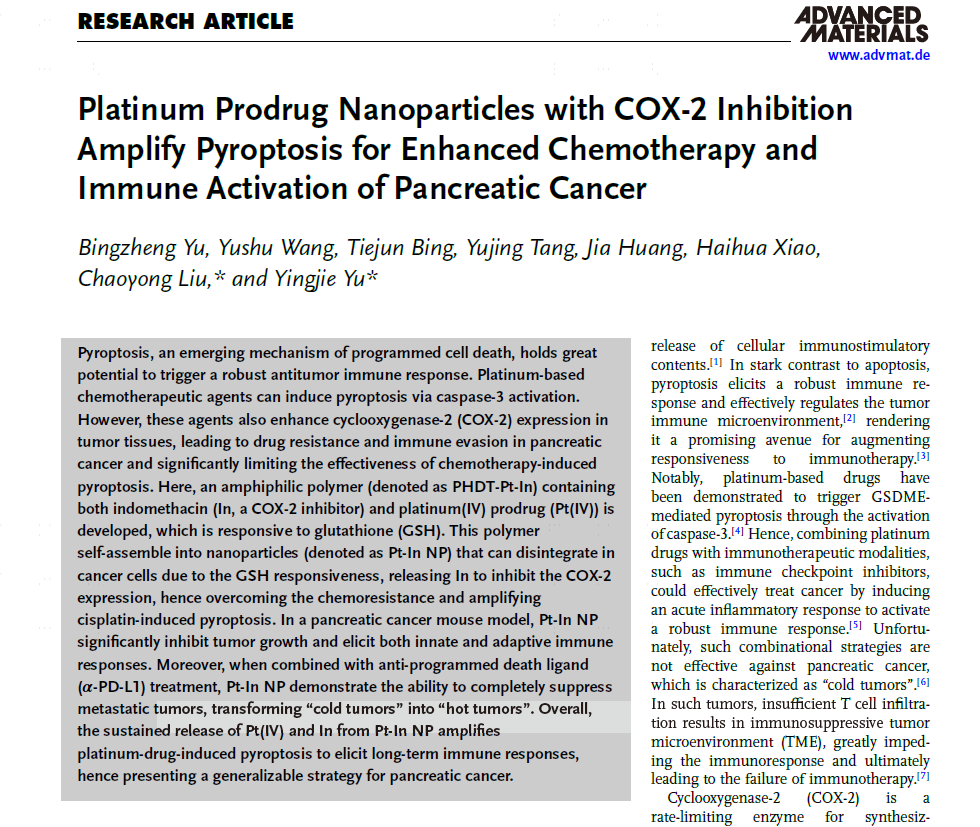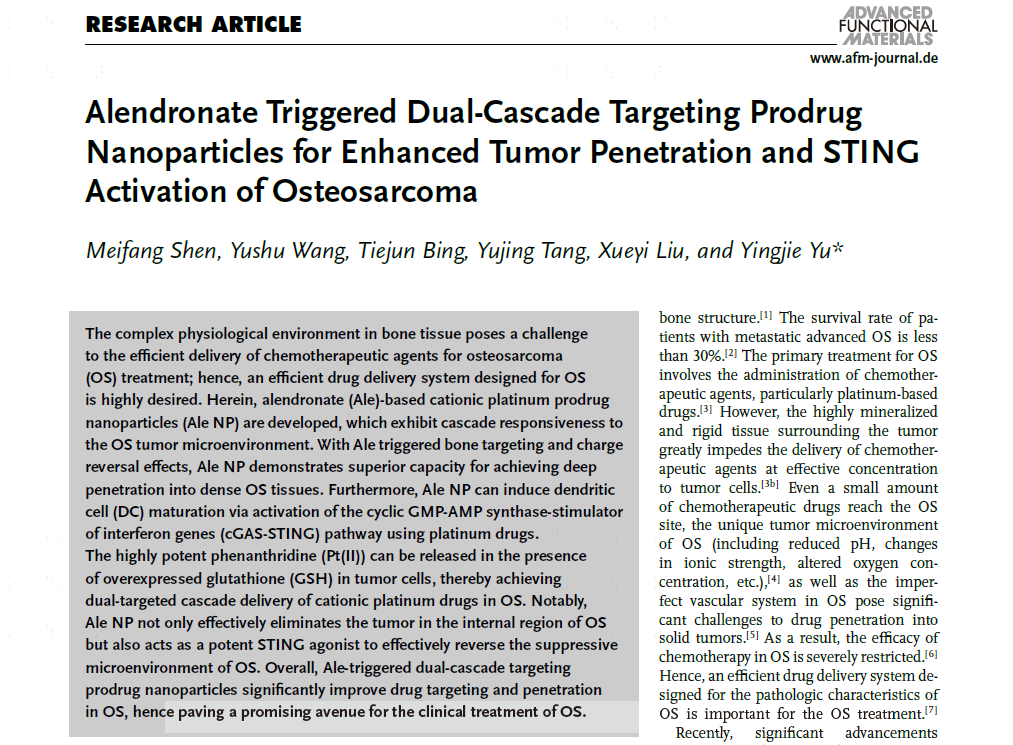
We are proud to have supported the research with our expertise in Western blot analysis, which was instrumental in assessing the expression levels of proteins crucial to cuproptosis, a novel cell death mechanism.
Abstract
Cuproptosis, an emerging form of programmed cell death, has received tremendous attention in cancer therapy. However, the efficacy of cuproptosis remains limited by the poor delivery efficiency of copper ion carriers. Herein, copper complex nanoparticles (denoted as Cu(I) NP) are developed that can efficiently deliver copper complex into cancer cells to induce cuproptosis. Cu(I) NP demonstrate stimulus-responsive release of copper complexes, which results in mitochondrial dysfunction and promotes the aggregation of lipoylated dihydrolipoamide S-acetyltransferase (DLAT), leading to cuproptosis. Notably, Cu(I) NP not only induce cuproptosis, but also elicit robust immune responses to suppress tumor growth. Overall, this study provides a promising strategy for cuproptosis-based cancer therapy.

Our Western blot analysis was used in the article to assess the expression levels of proteins critical to the study, such as COX-2.
Abstract
Pyroptosis, an emerging mechanism of programmed cell death, holds great potential to trigger a robust antitumor immune response. Platinum-based chemotherapeutic agents can induce pyroptosis via caspase-3 activation. However, these agents also enhance cyclooxygenase-2 (COX-2) expression in tumor tissues, leading to drug resistance and immune evasion in pancreatic cancer and significantly limiting the effectiveness of chemotherapy-induced pyroptosis. Here, an amphiphilic polymer (denoted as PHDT-Pt-In) containing both indomethacin (In, a COX-2 inhibitor) and platinum(IV) prodrug (Pt(IV)) is developed, which is responsive to glutathione (GSH). This polymer self-assemble into nanoparticles (denoted as Pt-In NP) that can disintegrate in cancer cells due to the GSH responsiveness, releasing In to inhibit the COX-2 expression, hence overcoming the chemoresistance and amplifying cisplatin-induced pyroptosis. In a pancreatic cancer mouse model, Pt-In NP significantly inhibit tumor growth and elicit both innate and adaptive immune responses. Moreover, when combined with anti-programmed death ligand (α-PD-L1) treatment, Pt-In NP demonstrate the ability to completely suppress metastatic tumors, transforming “cold tumors” into “hot tumors”. Overall, the sustained release of Pt(IV) and In from Pt-In NP amplifies platinum-drug-induced pyroptosis to elicit long-term immune responses, hence presenting a generalizable strategy for pancreatic cancer.

Our Western blot analysis was instrumental in assessing the expression levels of proteins crucial to the study, such as those involved in DNA damage response and STING pathway activation.
Abstract
The complex physiological environment in bone tissue poses a challenge to the efficient delivery of chemotherapeutic agents for osteosarcoma (OS) treatment; hence, an efficient drug delivery system designed for OS is highly desired. Herein, alendronate (Ale)-based cationic platinum prodrug nanoparticles (Ale NP) are developed, which exhibit cascade responsiveness to the OS tumor microenvironment.With Ale triggered bone targeting and charge reversal effects, Ale NP demonstrates superior capacity for achieving deep penetration into dense OS tissues. Furthermore, Ale NP can induce dendritic cell (DC) maturation via activation of the cyclic GMP-AMP synthase-stimulator of interferon genes (cGAS-STING) pathway using platinum drugs. The highly potent phenanthridine (Pt(II)) can be released in the presence of overexpressed glutathione (GSH) in tumor cells, thereby achieving dual-targeted cascade delivery of cationic platinum drugs in OS. Notably, Ale NP not only effectively eliminates the tumor in the internal region of OS but also acts as a potent STING agonist to effectively reverse the suppressive microenvironment of OS. Overall, Ale-triggered dual-cascade targeting prodrug nanoparticles significantly improve drug targeting and penetration in OS, hence paving a promising avenue for the clinical treatment of OS.